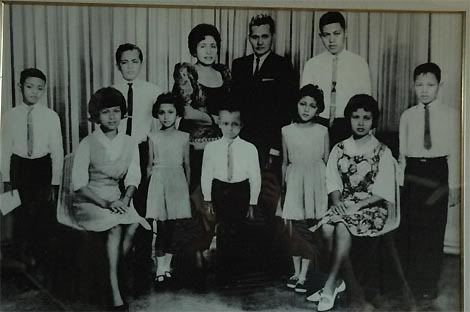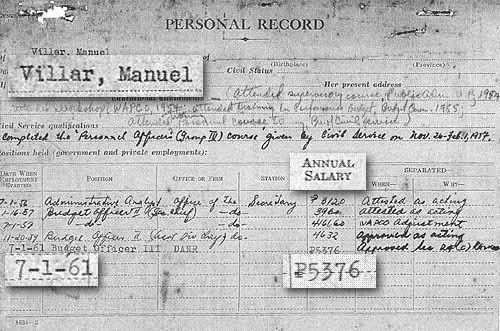In 1961, when Liberal Party standard-bearer Diosdado Macapagal was in the midst of a victorious presidential campaign, today’s presidential aspirant Manny Villar Jr. was 11 years old and living with his large extended family in a rented three-story corner house along Tondo’s main tree-lined boulevard, Moriones Street.
Villar’s father, Manuel Sr., was a US-educated Philippine government budget officer and his mother was an enterprising fish dealer, one of a privileged few with a choice stall in Divisoria market, one of Manila’s busiest.
By that year, Evelyn Villar, Manny’s aunt and Manuel Sr.’s sister, had already been a leading lady in movies produced by the major studio LVN. Evelyn hung out with Rosa Rosal, Delia Razon and other LVN stars at the time, and would occasionally sleep over in the Moriones house.
It was also a time when, candidate Manny Villar would like voters to believe, his family was almost desperately poor, judging from the songs, rhetoric and political ads that have formed the main narrative of his political campaign.
"Ako, noong first 11 years of my life, talagang squatter kami noong araw. Lahat, dinaanan ko yan," the senator said two weeks ago.
In 1962, as Villar was turning 13, his younger brother Danny, then three, died of leukemia, after his family had already transferred from Moriones to the upscale San Rafael Village in North Balut, Tondo (San Rafael village spans the border between Tondo and Navotas).
But in a political ad that has stopped airing, Villar claimed that his family was so poor then that they couldn’t buy the medicines that could have saved his brother’s life.
A studio photograph taken of the Villar family when the future senator, standing right back row, was in college. The young child in the front is actually the deceased Daniel Villar, who was not alive when the original photo was taken. It was only recently that the Villar family had the photo digitally altered to include Danny's image. "Gusto kasi namin kumpleto kami sa photo," said Vicky Villar- Divinagracia. Danny died before the age of four in 1962.
His critics and political opponents have since challenged the veracity of his claims to childhood destitution, leading Villar and his allies to back track a bit and halt some of the more questionable ads proclaiming his pauper roots, including the now famous music ad about swimming in a sea of garbage and spending Christmas on the streets, as if Villar and his siblings were urchins caroling to motorists.
The argument about the Villar family’s true economic status has become one of the bitterest bones of contention in this overheated political season, and has led to spirited exchanges in the media and on the web about what constituted real poverty in the early 1960s.
GMANews.TV has spent the past month trying to get to the bottom of Villar’s childhood poverty claims, interviewing neighbors, family members, and retired and active fish vendors who used to source their fish from Manny’s mother, Curing. She was acknowledged by both family members and her fellow-fish dealers as the entrepreneur in the family, and whom the candidate credits for teaching him the rudiments of business.
Manuel Villar Sr.'s government income
We also obtained from government archives the partial government employment records of the late Manuel Villar Sr. from 1938 to 1961 (his records beyond that year have not yet been found). Together with accounts from Curing’s fellow vendors of how much she was probably earning at the time, a fairly accurate picture has emerged for the first time of the Villar family’s income and what it could be worth in today’s money.
According to Manuel Villar Sr.’s salary record in 1961 as a rising official in the then-Department of Agriculture and Natural Resources, he was earning P448 a month or P5376 a year. It does not sound like much but the value of money was much different then. The minimum wage was four pesos a day, and an eight-ounce soft drink was 10 centavos or less. The elder Villar was earning an average of P22 a day.
Significantly, according to a household income survey in 1961 conducted by the National Statistics Office, the average annual individual income in that year was only P1,105. In other words, Manny Villar’s father was earning nearly five times the average income at the time.
Using the consumer price index from both 1961 and 2009 available on the National Statistics Office web site, we calculated the equivalent of P448 in 1961 to be P35,392 in today’s money, Manuel Villar Sr.’s monthly salary when adjusted for inflation. His rank in the civil service then was Budget Officer III.
Even in 1957, when the candidate says the family was much poorer, his father was earning P3960 a year at a time when the average individual income was P924 per annum.
Manuel Villar Sr. had started out in the government service in 1938 as a laboratory helper and became a junior fish warden during World War II. According to his employment records, Manuel Sr. studied fisheries in the United States as a "pensionado" or government scholar in 1948-49. When he returned to the Philippines, he was soon made a section chief and he continued to rise in both rank and salary.
Being a government employee was a relatively comfortable situation in the 1950s and 60s, especially for the rare one who had studied abroad on a scholarship. Government officials were much better paid in those days and, without the reputation for corruption attached to government service today, they enjoyed greater prestige in the community.
“They were definitely middle class," said Dr. Cielito Habito, an economist at Ateneo de Manila University and a former head of the National Economic and Development Authority, or NEDA, who helped GMANews.TV convert the elder Villar's income to today’s money.
A double income family
But the father’s regular salary was just one income in the Villars’ double-income family. The main breadwinner was actually Manny’s now famous mother Curing. According to several fish market vendors and their children who worked alongside the Villars in the Divisoria market in the 1960s, Curing earned no less than P80 a day and could have averaged as much as P600 a day after building up a steady customer base that included restaurants and nearby offices to whom she delivered fresh fish.
Using the factor of 79, based on the Consumer Price Index, that’s the equivalent of P6,320 to P47,400 a day in 2010. The lower figure was recalled by Eduardo Artures, 69, who worked in the same market in his teens and who knew the Villars.
The higher figure was cited by retired fish vendor Lelet Buenviaje, 68, who worked in Divisoria for nearly 40 years and sold shrimp just a few stalls a way from Curing. She recalls Manny Jr. as a hard-working son who often assisted his mother.
Lelet Buenviaje, 68, began selling seafood at the Divisoria Market in 1960, the year she got married. She would regularly purchase shrimp from Curing Villar, who she remembers as hard-working and humble. DANNY PATA
She vividly recalls Curing being one of the most successful Divisoria seafood wholesalers during the 1960s. She herself would buy seafood from Aling Curing on a nearly daily basis, which she would then retail.
“Kasi kung minsan tinatanghali ako, wala na kong aabutan sa labas eh," recalls Lelet. “Minsan kumukuha ako 20 kilos, hanggang 30 (kilos). Pinakamababa 10 kilos ang kuha ko sa kanya. Napapautang niya kami. Kinabukasan ang bayad. Mabait si Aling Curing."
Lelet remembers most of Aling Curing’s customers being seafood vendors themselves as well, not ordinary consumers.
“Halimbawa may naligaw na buyer na bibili ng tingi, nagbebenta din siya. Pero mas marami siyang suki sa mga nagtitinda," remembers Lelet.
However, Senator Villar has insisted that his mother was never a wholesaler. “We were not in wholesaling. We were ordinary vendors selling shrimps in public markets, which I’ve been saying for so many times," he has said. “Tatlong banyera lamang ang tinda namin. Noong bandang huli, noong ako ay nasa college na, medyo dumadami-dami na yung tinda namin."
Results 1 to 2 of 2
-
04-26-2010, 07:55 PM #1
 Villar’s Tondo roots were ‘definitely middle class’
Villar’s Tondo roots were ‘definitely middle class’
-
04-26-2010, 08:30 PM #2


Laagan tingali ni si Villar pagka bata.Kay mag pasko man sa gitna ng kalsada ug maligo pa sa dagat ng basura nga may kaya man diay iyang pamilya.
Advertisement
Similar Threads |
|







